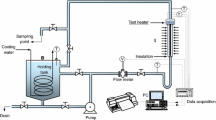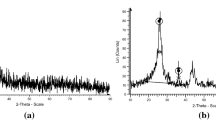Abstract
In the present investigation both numerical and experimental studies have been performed for SiO2/water nanofluid in different concentrations in the jacket side of a reactor that was equipped with a conventional jacket without baffle. Heat transfer rates were measured for nanofluid and base liquid. In order to solve the continuity, momentum, energy and turbulence equations, finite volume method and k–e turbulence model were utilized in three dimensions. For very dilute nanofluids (<0.1% volume fraction) no heat transfer enhancement was observed. For greater concentrations heat transfer rates augmented to some extent. Nusselt number increased with increasing the nanofluid concentration as well as Reynolds number. By using the least square method to all the experimental data two correlations for water and nanofluid were obtained.














Similar content being viewed by others
Abbreviations
- A i :
-
Inside heat transfer area (m2)
- A j :
-
Outlet heat transfer area (m2)
- Cp i :
-
Specific heat of liquid inside the vessel (J/kg K)
- Cp nf :
-
Specific heat of nanofluid (J/kg K)
- Cp j :
-
Specific heat of liquid inside jacket (J/kg K)
- Cp w :
-
Specific heat of water (J/kg K)
- Cp s :
-
Specific heat of nanoparticles (J/kg K)
- D:
-
Vessel diameter (m)
- \(D_{eq}\) :
-
Equivalent diameter of jacket (m)
- d c :
-
Diameter of jacket (m)
- D:
-
Agitator diameter (m)
- De:
-
Dean number
- \(h_{i}\) :
-
Mixing vessel side heat transfer coefficient
- h j :
-
Heat transfer coefficient of jacket side
- k i :
-
Thermal conductivity of liquid inside vessel (W/m K)
- k j :
-
Thermal conductivity of liquid inside jacket (W/m K)
- \(k_{f}\) :
-
Thermal conductivity of fluid (W/m K)
- k nf :
-
Thermal conductivity of nanofluid (W/m K)
- k p :
-
Thermal conductivity of particles (W/m K)
- L:
-
Length of the vessel (m)
- N:
-
Rotation speed (rpm)
- q j :
-
Flow rate of the cooling liquid (m3/s)
- Q:
-
Heat flux (W)
- r 1 :
-
Inlet radius of vessel (m)
- r 2 :
-
Outlet radius of vessel (m)
- t c :
-
Clearance of jacket (m)
- T in :
-
Outlet temperature of cold liquid (°C)
- T out :
-
Inlet temperature of cold liquid (°C)
- U:
-
Overall heat transfer coefficient (W/m2 k)
- ρ i :
-
Density of water inside the vessel (kg/m3)
- ρ j :
-
Density of liquid inside the jacket (kg/m3)
- ρ w :
-
Water density (kg/m3)
- ρ s :
-
Density of nanoparticles (kg/m3)
- ρ nf :
-
Density of nanofluid (kg/m3)
- μ bulk :
-
Viscosity of liquid inside the vessel (Pa s)
- μ nf :
-
Viscosity of nanofluid (Pa s)
- μ w :
-
Viscosity of water (Pa s)
- μ wall :
-
Viscosity of liquid near the wall (Pa s)
- ϕ:
-
Nanoparticle volume fraction
References
Choi SUS (1995) Enhancing thermal conductivity of fluids with nanoparticles. ASME Publ Fed 231:99–106
Choi SUS, Zhang ZG, Yu W, Lockwood FE, Grulke EA (2001) Anomalous thermal conductivity enhancement in nanotube suspensions. Appl Phys Lett 79:2252–2254
Li S, Eastman JA (1999) Measuring thermal conductivity of fluids containing oxide nanoparticles. J Heat Transf 121:280–289
Wang X, Xu X, Choi SUS (1999) Thermal conductivity of nanoparticle—fluid mixture. J Thermophys Heat Transf 13:474–480
Eastman JA, Choi SUS, Li S, Yu W, Thompson LJ (2001) Anomalously increased effective thermal conductivities of ethylene glycol-based nanofluids containing copper nanoparticles. Appl Phys Lett 78:718–720
Zamzamian A, Oskouie SN, Doosthoseini A, Joneidi A, Pazouki M (2011) Experimental investigation of forced convective heat transfer coefficient in nanofluids of Al2O3/EG and CuO/EG in a aouble pipe and plate heat exchangers under turbulent flow. Exp Therm Fluid Sci 35:495–502
Pantzali MN, Mouza AA, Paras SV (2009) Investigating the efficacy of nanofluids as coolants in plate heat exchangers (PHE). Chem Eng Sci 64:3290–3300
Garoosi F, Jahanshaloo L, Garoosi S (2015) Numerical simulation of mixed convection of the nanofluid in heat exchangers using a Buongiorno model. Powder Technol 269:296–311
Foli K, Okabe T, Olhofer M, Jin Y, Sendhoff B (2006) Optimization of micro heat exchanger: CFD, analytical approach and multi-objective evolutionary algorithms. Int J Heat Mass Transf 49(5):1090–1099
Rennie TJ, Raghavan VG (2006) Numerical studies of a double-pipe helical heat exchanger. Appl Therm Eng 26(11):1266–1273
Kanaris AG, Mouza AA, Paras SV (2006) Flow and heat transfer prediction in a corrugated plate heat exchanger using a CFD code. Chem Eng Technol 29(8):923–930
Galeazzo FC, Miura RY, Gut JA, Tadini CC (2006) Experimental and numerical heat transfer in a plate heat exchanger. Chem Eng Sci 61(21):7133–7138
Garvin J (2001) Estimate heat transfer and friction in dimple jackets. Chem Eng Prog 97:73–75
Fogg FM (1973) Heat transfer resistance in half-tube and dimpled jackets. Chem Eng Prog 69:76–80
Dhotre MT, Murthy ZVP, Jayakumar NS (2006) Modeling & dynamic studies of heat transfer cooling of liquid in half-coil jackets. Chem Eng J 118:183–188
Subramanian JN, Mjalli FS (2008) The dynamics of liquid cooling in half-coil jackets. Chem Prod Process Model 3(1):1–16
Perry RH, Green DW (1999) Perry’s chemical engineers’ handbook. McGraw-Hill, New York
Incropera FP, DeWitt DP (1934) Introduction to heat transfer. Wiley, London
Karcz J, Strȩk F (1995) Heat transfer in jacketed agitated vessels equipped with non-standard baffles. Chem Eng J Biochem Eng J 58:135–143
Sundar LS, Singh MK (2013) Convective heat transfer and friction factor correlations of nanofluid in a tube and with inserts: a review. Renew Sustain Energy Rev 20:23–35
Sundar LS, Sharma KV, Naik MT, Singh MK (2013) Empirical and theoretical correlations on viscosity of nanofluids a review. Renew Sustain Energy Rev 25:670–686
Xuan Y, Roetzel W (2000) Conceptions for heat transfer correlation of nanofluid. Int J Heat Mass Transf 43:3701–3707
Yu W, Choi SUS (2003) The role of interfacial layers in the enhanced thermal conductivity of nanofluids: a renovated Maxwell model. J Nanoparticle Res 5:167–171
Launder BE, Spalding DB (1972) Lectures in mathematical models of turbulence. Academic Press, Cambridge
Markatos NC (1986) The mathematical modeling of turbulent flows. Appl Math Model 10(3):190–220
Acknowledgements
The authors gratefully acknowledge the Chemical Engineering Laboratory at Isfahan University of Technology.
Author information
Authors and Affiliations
Corresponding author
Additional information
The original version of this article was revised: An author ‘Mohsen Nasr Esfahany’ is included in the list of authors and the Affiliation of the first and second author were corrected.
An erratum to this article is available at http://dx.doi.org/10.1007/s00231-017-2035-2.
Rights and permissions
About this article
Cite this article
Hafezisefat, P., Nasr Esfahany, M. & Jafari, M. An experimental and numerical study of heat transfer in jacketed vessels by SiO2 nanofluid. Heat Mass Transfer 53, 2395–2405 (2017). https://doi.org/10.1007/s00231-017-1989-4
Received:
Accepted:
Published:
Issue Date:
DOI: https://doi.org/10.1007/s00231-017-1989-4




